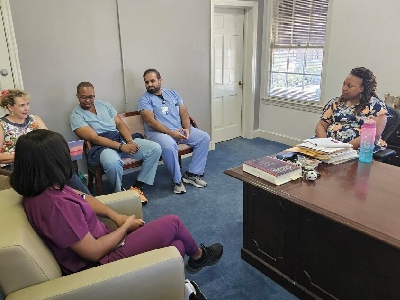Residency
Program Overview
How many residents are in the program?
We are a 10-10-10 residency program. We value teamwork and having our interns join our family within Family Medicine.

How available are attending physicians?
All rotations are supervised and have an attending physician readily available around the clock, either in person or on call. Our Family Medicine attendings round with our unopposed inpatient service team every morning and are on call starting at 7 pm. All residents receive a copy of faculty phone numbers and are encouraged to reach out at any time.
Do residents meet individually with program leadership?
Residency leadership has an open-door policy and encourages residents to feel free to stop in or schedule meetings as needed. All residents meet individually with the program director or associate program directors semi-annually to review individualized learning plans, progress and to provide feedback on the program.
What are the opportunities for scholarship?
Residents are required to complete a quality improvement project during their residency. There are many opportunities to engage in a wide range of scholarly activities, including case reports, original research, poster presentations, review articles, etc. Residents will be paired with a faculty member to assist with these projects.
How are residents evaluated?
Our program uses the MedHub software for evaluation distribution. Evaluations are scheduled monthly for clinic, hospital and rotations. Both residents and faculty can submit evaluations and feedback “on the fly” at any time. All evaluations are anonymous to encourage honest feedback. We strongly encourage faculty to provide direct one-on-one feedback on any service or activity. Our clinical competency committee reviews all evaluations and submits summary information for semi-annual meetings. Residents can review their performance evaluations at any time and utilize MedHub to track all procedures, scholarly activity, access schedules and more.
 How do residents provide feedback to the program and attendings?
How do residents provide feedback to the program and attendings?
There are multiple avenues for residents to provide feedback to the program, faculty and staff, and peers. Our chief residents hold monthly meetings and are available to voice any concerns anonymously. Our program leadership also has an open door/contact policy where residents are able to contact them to voice any concerns. Monthly clinic business meetings are another opportunity to address clinic operations or identify and troubleshoot concerns. Our feedback systems allow for anonymous “on the fly” evaluations for faculty, staff and peers. These evaluations are pooled and then released to create a greater anonymity. Finally, our Department Chair, Dr. Pittman, is also available and encourages any feedback as well.
Will I have mentor or advisor?
All residents will complete an individualized learning plan (ILP). This plan includes wellness goals, academic/scholarly goals as well as plans for future practice. ILPs are reviewed semiannually and mentors can be identified to assist with any part of your learning goals. Mentorship can be viewed as static, consistent and stable, or on demand, assigned when you need guidance in a particular area and periodically. Mentorship and advisement are customized to meet your learning needs.
What is your pass rate on the Family Medicine Board exam?
Our ABFM passage rate is at 100% for well over the past 5 years. We do offer a free board review course that is available to all residents. Ongoing board review opportunities are a part of our scheduled didactics as well.
How is call structured?
Our inpatient service is primarily covered in 12-hour shifts. However, so that all our residents get at least one day per week off, Residents rotate weekend coverage for inpatient service. Generally, PGY2 residents will cover up to 8 Saturday/Sunday shifts per year and PGY3 residents will cover 5-6. Generally, every resident will have only one 24-hour call per year.
What is the average patient volume and demographics in clinic and hospital?
UMMC Madison is an adult hospital where, on average, we have 15 patients on service per day, which are divided among the residents covering the inpatient service. We admit patients from all socioeconomic strata.
How do your residents get pediatric exposure?
Our residents fulfill the RRC requirements for pediatric exposure. Our UMMC inpatient pediatric experience is quite robust; UMMC has the only dedicated children’s hospital in Mississippi.
What other inpatient and ER experiences are available to your residents?
Our residents rotate through a variety of inpatient settings. As the only academic medical center and Level One trauma center in Mississippi, the UMMC rotations are especially filled with tertiary-level care and consultations.
What procedures are available to your residents?
We have a number of procedures that are performed in our Family Medicine Clinics. These procedures include but are not limited to: Skin biopsy (shave, punch, excisional), Nexplanon implantation and removal, joint injections (such as knee and shoulder, carpal tunnel, and trigger finger), Cryotherapy, Pap, and toenail removal.
Do you have required remote rotations?
At this time, we do not have any required away rotations. We do have opportunities for a rural dermatology elective, where housing is provided. However, it is not required.


